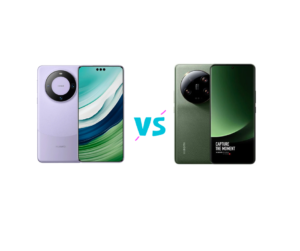Two premium smartphones introduced in 2023 will be compared in this article: the Huawei Mate 60 Pro and the Xiaomi 13 Ultra.
While the Xiaomi 13 Ultra runs Android 13 with MIUI 14 and has a Qualcomm Snapdragon 8 Gen 2 CPU, the Huawei Mate 60 Pro is powered by HarmonyOS 4.0 and has a Kirin 9000S chipset.

Product Comparison:
| Categories | Huawei Mate 60 Pro | Xiaomi 13 Ultra |
|---|---|---|
| Design | Glass front, aluminum frame, glass back | Glass front (Gorilla Glass Victus), eco leather back, aluminum frame |
| Display | 6.82 inches LTPO OLED, 1B colors, 120Hz | 6.73 inches LTPO AMOLED, 1B colors, 120Hz, Dolby Vision, HDR10+ |
| CPU & GPU | Kirin 9000S (5 nm) | Snapdragon 8 Gen 2 (4 nm) |
| Storage | 256GB 12GB RAM, 512GB 12GB RAM, 1TB 12GB RAM | 256GB 12GB RAM, 512GB 12GB RAM, 512GB 16GB RAM, 1TB 16GB RAM |
| Camera | 50 MP + 48 MP + 12 MP (Triple) | 50 MP + 50 MP + 50 MP + TOF 3D (Quad) |
| Battery | Li-Po 5000 mAh, non-removable | Li-Po 5000 mAh, non-removable |
| Price | About 890 EUR (converted from RMB) | About $900 |
Design:
The glass front, metal frame, and glass back of the Huawei Mate 60 Pro give it a svelte and expensive appearance.
The Xiaomi 13 Ultra, on the other hand, has a distinctive and fashionable design with a glass front (Gorilla Glass Victus), eco leather back, and aluminum frame.
Display:
The 6.82-inch LTPO OLED display on the Huawei Mate 60 Pro has a 120Hz refresh rate and offers slick and bright images.
The Xiaomi 13 Ultra, on the other hand, has a slightly smaller 6.73-inch LTPO AMOLED screen with a 120Hz refresh rate, Dolby Vision support, and HDR10+ compatibility, making it perfect for multimedia use.
CPU & GPU:
A Kirin 9000S chipset, which provides great performance and power efficiency, powers the Huawei Mate 60 Pro.
On the other hand, the Xiaomi 13 Ultra has a Snapdragon 8 Gen 2 CPU, which offers quick and effective performance.
Storage:
Both smartphones include a variety of storage options, letting customers select the size that best meets their need.
Along with 12GB of RAM, the Huawei Mate 60 Pro offers storage options of 256GB, 512GB, or 1TB.
With the addition of models for 512GB with 16GB of RAM and 1TB with 16GB of RAM, the Xiaomi 13 Ultra provides the same options for 256GB and 512GB.
Camera:
Users of the Huawei Mate 60 Pro may take high-definition pictures and movies thanks to the device’s triple camera configuration, which consists of a 50MP primary lens, a 48MP periscope telephoto lens, and a 12MP ultrawide lens.
The Xiaomi 13 Ultra, on the other hand, has a quad-camera arrangement that includes a 50MP wide lens, a 50MP periscope telephoto lens, a 50MP telephoto lens, and a TOF 3D depth sensor. This allows users to shoot beautiful and detailed pictures from a variety of angles and distances.
Battery:
The non-removable 5000mAh batteries in both smartphones provide long-lasting battery life.
88W wired charging, 50W wireless charging, and 20W reverse wireless charging are all supported by the Huawei Mate 60 Pro.
On the other hand, the Xiaomi 13 Ultra supports 10W reverse wireless charging, 50W wireless charging, and 90W wired charging.
Huawei Mate 60 Pro vs Xiaomi 13 Ultra: PROS and CONS
Huawei Mate 60 Pro
PROS:
- Premium design with glass front and back
- Large and vibrant LTPO OLED display
- Powerful Kirin 9000S chipset
- Multiple storage options
- Versatile triple-camera setup
- Fast wired and wireless charging capabilities
- Satellite Calling support
CONS:
- Higher price compared to other flagship smartphones
- Limited Availability
Xiaomi 13 Ultra
PROS:
- Unique design with eco-leather back
- Impressive LTPO AMOLED display with Dolby Vision and HDR10+ support
- Snapdragon 8 Gen 2 chipset for faster and more efficient performance
- Ample storage options with high RAM variants
- Quad-camera setup with Leica lenses
- Fast wired and wireless charging capabilities
CONS:
- No satellite calling or texting
